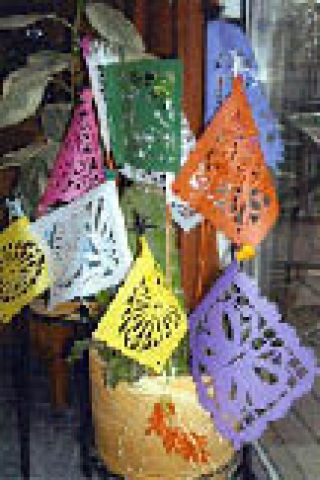The art of cutting paper can be found around the world, but Beatriz Diaz Goodpasture was inspired by the techniques from her family heritage, that of Mexico.
“My parent’s ancestors are from there,” Goodpasture said. She grew up in California and followed a son here to the Pacific Northwest.
“I love the green trees,” Goodpasture said.
Although she learned the art form as an adult, she may now be considered an expert in the art of “papel picado.” Goodpasture teaches at Michael’s arts and crafts stores as well as special events, like the upcoming Day of the Dead celebrations at the Tacoma Art Museum Nov. 2 and at the Phinney Community Center in north Seattle on Nov. 7.
“At the art museum, I will be teaching workshops on ‘enramada,’” Goodpasture said. “That’s the chain of flags. It’s name comes from the word ‘rama’ or vine.”
The next week she will be making shadow boxes and shrines at the Phinney Arts Day of the Dead, Nov. 7.
At the Arlington Library Oct. 10, she will help children and their families make colorful paper flags to mount on sticks.
She plans to offer three different designs, an accordian, a flower and a fan design for adults.
“It’s open to anyone who can handle scissors, or who is ready to learn about handling scissors,” Goodpasture said she learned the art form as an adult when she was teaching in Los Angeles. I met a woman who made beautiful Mexican paper cutting, but it took six years to convince her to teach a workshop.
“When I was a kid, all I did was the regular snowflakes.”
Literally translated as perforated or pricked paper, “papel picado” is a pre-Columbian folk art. Indigenous people used handmade papers called ‘amate’ made from mulberry bark to create decorations for religious and healing rituals.
A dramatic change came when Filipino and Chinese traders arrived at the port of Acapulco. They introduced ‘papel chino’ made of tissue paper.
“Mexicans found ‘papel chino’ easier to cut and easy to dye into many colors,” Goodpasture said. So “papel chino” continues to be the paper of choice for “papel picado” art projects.
The punctured papers can be used in many different formats, from flags to banners to lattice curtains, and they are used to decorate for all kinds of parties, including weddings, birthdays and retirements as well as Day of the Dead celebrations.
Traditional “papel picado” sheets take from 8 to 10 hours to cut. Artisans use a variety of chisels, Exacto knives and wood-carving tools are used to cut through 30 to 40 sheets of tissue paper at a time.
From Everett, Goodpasture is a regular at the monthly Artist Trading Cards event at Evonnes in downtown Arlington, but this is her first presentation at the Arlington Library.
“I hope some people will come,” said Arlington’s new children’s librarian, Lesla Ojeda.
“You never know what’s going to attract a crowd.”
Goodpasture’s presentation is provided with support from the Friends of the Arlington Library.
For information about Beatriz Diaz Goodpasture are see the Web site at mexicanpapercrafts.com.








